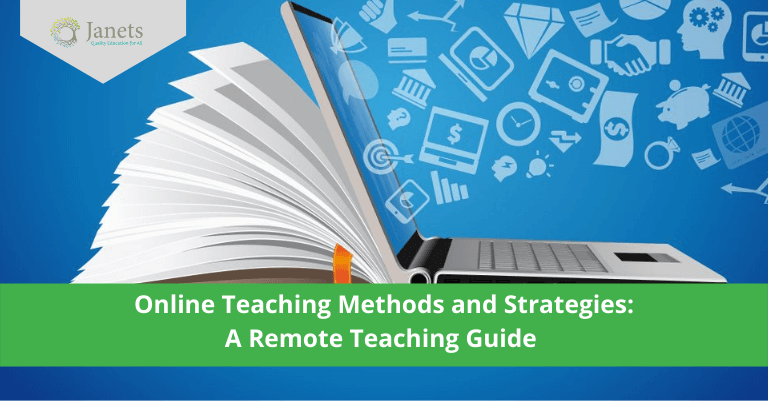Online teaching has gained immense popularity over the years. Its flexibility, student and teacher engagement, and cost-effectiveness have captured the attention of many. However, it has acquired more popularity in recent times due to the spread of the COVID-19 virus worldwide. In this article, we will be discussing the different online teaching methods and strategies. So, if you are in the teaching profession or aspiring to be one, this article is a must-read for you!
Table of Contents
15 Online Teaching Methods and Strategies
1. Familiarise Yourself With the Technology
2. Check Course Contents Regularly
3. Set Expectations and Goals
4. Establish Trust and Comfort for Students
5. Mind Mapping
6. Prepare for Lessons in Advance
7. Provide Feedback
8. Engage With Your Students
9. Stay in Touch with Students’ Families
10. Refrain from Assigning Too Many Tasks
11. Come up With Exciting Activities
12. Collaboration With Co-workers
13. Acknowledgement Forms
14. Give Time Off
15. One to One Conversations
What is Online Teaching?
Online teaching is the process of teaching other individuals through a virtual platform. Several online tools are being used in online teaching. This includes Zoom calls, video conferencing, live calls, live chats, etc. In addition, several other online applications have been built and designed to make the online learning experience easier and more smooth. All of these technologies are making both teachers and students feel comfortable in gaining knowledge online. In addition, this form of teaching also engages students more, and it increases their participation level and interest in the subject.

Moreover, due to the advancement of modern technology, the quality of online education has improved over the years. Hence, there are reasonable amounts of people who prefer online learning to traditional learning. One of the main reasons is the global COVID-19 pandemic. The pandemic has played a significant role in promoting online teaching. Also, the correct teaching methods and strategies play an essential role in successful interaction with the students.
Online Teaching Methods and Strategies
Online teaching methods and strategies play a significant role in making the online learning process more user-friendly. They are very effective for new teachers and online educators. But, an essential thing that you need to secure first is – a good internet connection. This is the first and foremost thing when it comes to online teaching. So, once you have that sorted, take a deep breath.
However, online teaching requires different types of interactions with students. So, we’ve simplified what works into 15 strategies based on research and findings. These strategies and methods will help you and your students gain success in the online learning sessions.
1. Familiarise Yourself With the Technology
Technology is the most crucial tool for online teaching. Without this, there is no online learning. However, if this is something very new to you, you will be having some issues while teaching online. Therefore, it is vital to be tech-savvy if you are to teach online. You can watch several videos to familiarise yourself with modern technology. There are also various courses available to prepare you for teaching online.
Also, be precise to your students about where they should go for technical support. Make the contact information instantly available. And, be prepared to direct students there if they come to you. Finally, you should practice using all online platforms related to your teaching and guide your students into it. There should be no room for confusion because technology is the backbone of online learning.
2. Check Course Contents Regularly
There are several course contents and applications available for online learning. Therefore, you should frequently check all links, online resources, and modules. In addition, online content can move or change, which can lead to disengagement. Some students face issues accessing all the information, or it might not be accessible on their end. So, assist all students facing difficulties with course contents and modules and navigate through the web pages.
Moreover, you should model the process of navigating to websites that are not included in the course, and exhibit how to accurately manage to keep track of navigation when jumping from one site to another. Finally, there can be broken links, or the access might be denied due to privacy settings. So, look into all of these to ensure that the students do not have difficulty accessing learning materials.
3. Set Expectations and Goals
It is essential to set expectations that you would like to achieve from a particular online course. Setting expectations means pointing out things that need to be done and clearing any confusion. You can list expectations that you would like to gain from the course you are teaching. This will help you work towards a goal and be more productive. Online learning is new to some students as well. Therefore, make it clearer to students about the grading system and assessment criteria for the course. Make sure that they are constantly participating in all activities and discussions.

For instance, make it clear that you will respond to them via email within one or two business days if they have any queries. Otherwise, students might expect you to get back to them when they call or email you. There should not be any unrealistic expectations, and you can also share resources for students on being efficient online learners. So, set all these expectations for yourself and your students to ensure no room for miscommunication.
4. Establish Trust and Comfort for Students
Every teacher should always try to build a rapport with their students. They should make sure that they create an amicable and comfortable atmosphere to provide that comfort to the students. Trust and comfort between students and teachers help to beat all odds and make a beautiful relationship. During online classes, the students should feel comfortable to ask any questions to the teachers by being non-hesitant. They should never stay in fear, anxiety, or isolation during online learning sessions. You can also post a welcome video or photos that showcase stories about what you are doing to keep busy during COVID-19 lockdown, links to news, etc.
Additionally, you should encourage each student to personalise their homepage and spend time going around the class asking students to share information about what they have posted. Furthermore, you can encourage them to reach out to others via instant messaging, web cameras, blogs, or vlogs. Also, encourage them to ask questions that empower participants to question each other and indulge in a deep discussion. Moreover, as a teacher, you should always try to be compassionate towards your students and never try to intimidate them in any way. This is because their comfort would make them more productive as well.
5. Mind Mapping
Mind mapping is one of the best online teaching methods to indulge students in your virtual lessons. A mind map is a diagram of related concepts that can study, organise information, or conduct thorough research for any assignment. This helps teachers structure online classroom discussions, classify ideas, and gradually bring learners to the central idea. Mind mapping allows students to segregate tasks in their minds and group them into different categories. This will enable them to focus on each one of them more efficiently. Pupils can also brainstorm more on a topic. The purpose is not to complicate complex concepts or issues.

The advantages for online students are that it’s quick and easy and allows them to penetrate right into the idea pool quickly. For example, you can have students create their mind maps on paper or online mapping software. And they can share them with the rest of the class. Thus, it allows for easier penetration of ideas with each other. Moreover, this method is suitable for making connections, planning, and an in-depth understanding of a subject.
6. Prepare for Lessons in Advance
If you encourage your students to prepare in advance, they will have more idea on the topic being discussed during the class timing. Preparing lessons in advance involves reading the lesson outlines, brainstorming on an essential topic in advance, or complete assignments before attending the online class. In addition, class time is used to discuss the lesson further, share ideas and allow students to interact in a vibrant learning environment. To check if they have prepared anything beforehand, ask them an open-ended question, conduct a surprise multiple-choice test, or assign work.
For example, you can assign students to complete a particular lesson. From there, you can begin an online discussion. You can expect your students to hunt through the lessons, ask questions, and share their unique ideas. These measures would indulge them more in the study topic and further encourage them to prepare beforehand to do better in the class. And, the better they prepare on a topic, it is best for their own knowledge development. It would get more accessible for them to understand complex topics as well as get more time to work on a task. This method allows you to create a more versatile learning environment and better understand the discussion subject.
7. Provide Feedback
Feedbacks are essential in every matter. It can be both constructive or sound feedback.
It is a crucial element of all effective learning environments. Being a teacher, your feedback will leave a massive impact on a student’s learning cycle. It would help create an e-learning experience that is informative, engaging, and motivational for the student. For example, if someone has done an excellent job in their assignment, good feedback would act as a form of appreciation for them and push them further to do even better in the future.

On the other hand, if someone lacks in their work, you can suggest ways to prove their work. This is known as constructive feedback or constructive criticism. This kind of feedback helps individuals work on their mistakes and use them as a self-development tool. Therefore, your feedback should be a prominent part of the entire e-learning process. It would help your student to work on their skills and polish them.
Additionally, you can conduct group feedback sessions through several exercises and activities. Group feedback sessions increase student engagement, and they can also learn from each other’s mistakes. Thus, there is less probability of a similar mistake by a couple of students in the same class.
8. Engage With Your Students
Without your physical presence in classes, you must create a virtual reality starting your online course. Online teachers need to engage and support students from the start and for the course duration to maintain an influential learning community. Therefore, by establishing your presence, you’ll try to create a visual illusion for your students. You should always make them feel like they are always supervised even though there is only a virtual presence. And, you should be very accepting of their new learning environment, just as you would in any physical classroom.
Additionally, make sure you let your students know what times you will be available for them. Finally, engage with your learning community through online posts, emails, forums, or social media. When students see teachers investing time into discussions and engagement, they’ll be more encouraged to participate themselves. Student engagement also breaks any barriers to a student-teacher relationship. They feel less intimidated by the teachers. As a result, students develop better professional knowledge, become more confident, and build a stronger bond with their teachers.
9. Stay in Touch with Students’ Families
Staying engaged with students’ families allows teachers to know about any issues in their lives and give them any info about their children. Also, families want to hear from you often and get updates regarding their children. It can be easy for students and parents to start to feel disconnected in an online learning environment. Therefore, reassure them you are always available for a consultation. You can share your email and phone number early and often in multiple places and select a time in which you can dedicate to the guardians wholly.
A clear and respectful communication is the key to success and building relationships.
However, failing to do so can leave an adverse effect on the students. They would start feeling that their mistakes aren’t brought up in front of their guardians, and they start feeling that it is effortless for them to get away with any mistakes.
Also, if teachers can build a constant rapport with guardians, it is better for their child’s future. They would feel more responsible and finish tasks on time. This is because if there is any room for improvement for a child or a specific factor that they are constantly struggling with, both teachers and guardians can work together to minimise it.
10. Refrain from Assigning Too Many Tasks
Beware of assigning too many tasks and assignments without training your students to use the online platforms and tools first. Make sure not to overload the students with too much work on their plates. Families and students will not be capable enough of solving complex tasks if not explained adequately.

In addition, you don’t want your student spending more time trying to interpret the instructions than learning the actual content. Therefore, when assigning a task using a new technological tool, consider that it may take the students some extra minutes to one hour to get the hang of it. So, provide precise instructions with common troubleshooting tips.
11. Come up With Exciting Activities
As a teacher, you can use various exciting and adventurous activities to engage your students. You should try to meet everyone’s needs too. The primary goal should be to make your online teaching sessions very interesting. During the online sessions or after, you do activities such as show and tell, guess the name, 3 truths 1 lie, etc. All of these activities would strengthen your relationship with the students as well as with you.
Moreover, if you can develop a good relationship with your learners, they would find more interest in the classes. As a result, your classes would seem less monotonous to them. So, make your online courses more interactive and bring some bling!
12. Collaboration With Co-workers
Your co-workers are your friends at work. Therefore, you should always make sure that you collaborate with them and build a good relationship. This would bring you many advantages. For example, you can consult them if there is any confusion about a specific matter on your end. In addition, you and your co-workers can also collaborate with each other and come up with better ideas to improve the online learning experience for your students.

Even though you will not get to see them every day, just like traditional classes, they would still be the most valuable resource you can find while teaching. You can quickly feel alone at home with no support. But always remember to reach out and ask what your fellow teachers are doing in their virtual classrooms. They are also researching and testing new methods and strategies just like you are. That’s why sharing your mutual findings is beneficial to everyone.
13. Acknowledgement Forms
Acknowledgement forms are used to ensure that your student or parent has read an important document provided by you. Thus, they have to sign the form after reading the announcements. In this online environment, you’ll find yourself automatically thinking, “Does anyone ever read the emails or letters I send?” Therefore, you can add a Google form link to guarantee that the students and their parents read and understand any critical communications.

You can upload the acknowledgement form there and make the link available for everyone who has access to the link. This is where a student and parent will type their name to acknowledge they read and understood it. This process will reassure you that the information being passed by you is received and read by the other party.
14. Give Time Off
Who doesn’t enjoy time off between vigorous activities or learning sessions? Similarly, in online classes, you must allocate some time off for your learners. For example, you can give them a 10-15 minute break, and they could utilise this time to engage with each other, chat with you or get some refreshment for themselves. This time off plays a significant role in building connections with each other and get more comfortable. If possible, you could also arrange a 30-minute recess once a week, where students can log into a live meeting room just to hang out.
Then, if conversation lags or needs direction, you can introduce topics with icebreaker activities and try to engage everyone. Moreover, when someone is constantly listening about academic topics without a break, their minds get clogged up. Therefore, the time off acts like a dash of fresh air. It enables students to release any tension or pressure and makes them feel more energised when they are back.
15. One to One Conversations
Not every student functions at the same pace. For example, some students can be brilliant, whereas some might take more time to understand a topic. So, make a habit of reaching out to students who are struggling in their studies and assignments. You can call them personally or do a one on one video chat session. Discuss any issues and give suggestions to improve their condition. And, you could do this with all the students in your class. This would ensure that you know all your students personally.
Conclusion
Online teaching has secured a prominent place in our lives. There are several online teaching methods and strategies that have made this mode of teaching more effective. If you want to know more about online teaching methods, you can look into our Remote Teaching Online Course. This course is user-friendly, and 24/7 support is available!
Read more blogs
- The 15 Top Custom GPT Tools of 2024
- Why Every Employee Needs Data Analytics Skills in 2024
- Making the Most Out of Team Communication in 2024
- 10 Growth Marketing Strategies for 2024
- Christmas Cooking Guide: 10 Tips for Healthy Diet
- The Ultimate Guide to Healthy Diet During Holidays
- How to Become a Teaching Assistant with no Experience in the UK
- 10 Game-Changing Microsoft Office Hacks That You Must Know
- The Future of Work: How to Stay Relevant in a Changing Job Market
- The Ultimate Guide to Become A Care Worker in the UK





 LOGIN/Sign up
LOGIN/Sign up




